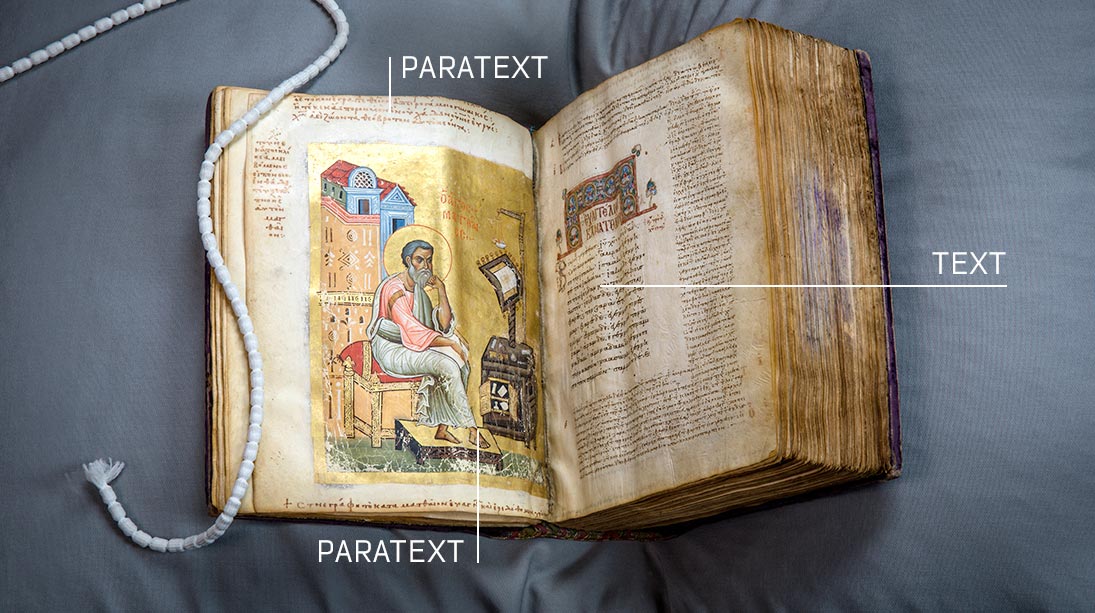What if religions supplemented textual knowledge with paratextual information? What if religions saw aesthetic paratexts as doorways to new spiritual information? Dr. Garrick V. Allen of Dublin City University is seeking to address these questions with reference to one particular illuminated Gospel book in the collection of the Chester Beatty.
It could be said that above all else Sir John Templeton’s aim was “to encourage researches for vastly more spiritual information to supplement the wonderful ancient scriptures.” More concretely, Sir John wanted to encourage researchers to draw on novel sources of data, and to follow progressive methods of intellectual discovery such as we find in the scientific method.
This project is seeking to supplement the wonderful ancient scriptures by drawing attention to the aesthetic paratexts of W 139 – a 12th Century deluxe Byzantine Gospel book – as novel sources of data, and then to analyze these features by leveraging existing tools such as XML from the science of textual criticism.
Once the data has been aggregated, and in conversation with Dr. Jean-Luc Jucker, Dr. Allen will then form testable hypotheses about the ways that paratexts contribute to our understanding.
We think a lot about how people access and consume content in today’s digital world, but rarely do we give paratexts the attention they deserve. According to the French literary theorist Gérard Genette, the paratext is “a threshold, or […] a ‘vestibule’ that offers the world at large the possibility of either stepping inside or turning back.”
From the title of the book to the size of its pages to the color of the text and the selection of images, paratextual features are “at the service of a better reception for the text and a more pertinent reading of it”. The text is made present through and mediated by these paratextual features. It is framed and shaped by its surroundings. And those surroundings influence how the book is read and understood.

But this insight has not yet been sufficiently understood with reference to the wonderful ancient scriptures. We toil over texts and translations, rarely taking account of paratextual features, but are we as a result missing out on insights hidden in plain sight?
Nothing we read is paratext-free. All writings, whether in print or digitally distributed, are framed and shaped by their material. Every choice has a purpose. Much of that intention is lost on the everyday reader, but decisions like the size of the text, color of ink, page layout, size and materials used, and the wording of a title, all influence how people engage with content. These are all paratextual choices.
Paratexts are those ubiquitous features of literature that are hidden in plain sight. “Paratexts are doorways into understanding the text and contextualizing it in a particular way,” Dr. Allen says. Artistic considerations are very valuable while considering the implications of paratext, but it is also important to take into account how and where the text is written. Examples of this can include:
This manuscript is rich with paratexts, including a wide range of aesthetic paratexts.
According to the philosopher Gordon Graham, “The visual artist […] is not a mere illustrator of texts. Even beautiful work incorporated directly into a sacred text is referred to as ‘illumination’ rather than illustration, signaling perhaps, that its role is to bring additional light and not merely provide exemplars. The role of the visual artist, then, may be said to go beyond recording or depicting, and to be an act of formative imagination in its own right.” (Philosophy, Art, and Religion, 73)
This may well be so, but is there an empirically demonstrable connection between aesthetic paratexts and understanding with reference to what Sir John referred to as spiritual reality and/or spiritual information in particular? And if so, what distinctive cognitive value does engagement with these aesthetic paratexts generate?
In order to address these questions, Dr. Allen is producing a digital edition and translation of W 139, focusing on editing its paratexts, and using the editorial platform of the New Testament Virtual Manuscript Room. This project will focus on refining the process of digital data aggregation, constructing preliminary hypotheses about the cognitive effects of paratexts on readers, and constructing experiments with this data that could test these hypotheses in a future larger-scale project.


